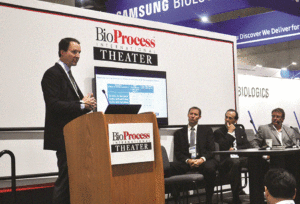- Sponsored Content
Panel Discussion: Process and Business Considerations for Innovation — Supplier and End-User PerspectivesPanel Discussion: Process and Business Considerations for Innovation — Supplier and End-User Perspectives
August 7, 2017
Sponsored Content
On Wednesday, 21 June 2017, BioProcess International presented a panel discussion from 11:00 am to 12:00 pm as part of the “Emerging Techniques and Technologies” session of its BPI Theater at the BIO annual convention in San Diego.

Left to Right: Stewart McNaull, Todd Menkhaus, Tom Ransohoff, and Bernard Huyghe (PHOTO BY LEAH J. ROSIN)
Moderated by Tom Ransohoff (vice president of BioProcess Technology Consultants), the panel comprised Stewart McNaull (senior vice president of business development at KBI Biopharma), Bernard Huyghe (senior director at Pfizer), John Bonham-Carter (director at Repligen, not pictured), and Todd J. Menkhaus (cofounder of Nanopareil).
With omnipresent demands to improve development speed, reduce costs, and improve product quality, the biopharmaceutical industry needs to evaluate and adopt new technologies for manufacturing and testing its products. In addition to the development costs and resources of implementing new technologies, significant regulatory, technical, and time line risks act as a brake on innovation. This panel explored business considerations for adopting new technologies and processes used by industry leaders to ensure successful implementation.
Discussion
How do we adopt new technology and make the case from a business point of view to bring them in? Ransohoff kicked off the discussion with an example: single-use bioreactors. The first of them was introduced 20 years ago, and today three companies offer bioreactors at the 2,000-L scale. Trends show that single-use bioreactors are adopted at a higher rate than stainless steel versions, but that they still represent a small part of the overall industry. Even for a technology with such a compelling business case, industry adoption takes time. “We want to explore why that is. We are a conservative industry because there are costs and risks in adopting new technologies. Penalties for delays and setbacks are severe. With the importance of speed-to-market and capital efficiency, increasing quality expectations, and interest focusing on costs, the industry is interested in innovation.
What are the most compelling drivers for adopting new technologies, and how can suppliers better convey and highlight those drivers to make the business case? Companies could do more market research before developing new products. But creativity also should be fostered. The inventors of 3-D printing didn’t know that it could be used in bioprocessing. Nanopareil’s founders realized that many single-use solutions were available for upstream production, but not many for downstream. Once that was targeted, end-users and potential partners made the case for them. “You need to be dabbling in innovative ideas all the time,” Menkhaus said.
Process scientists have to buy into new technology, but they aren’t the only ones. Who else needs to buy in before it will be adopted? You have to consider good manufacturing practice (GMP) manufacturing. The other stakeholders are engineers and validation groups who want to know how to validate a new technology, manufacturing groups who must be convinced that it will work from the start, and quality experts who want to a system to be under control and properly documented. Financially, will there be a good return from implementing new technology? Huyghe said that at Pfizer, a team of processing people, quality experts, analytical people, regulatory specialists, and procurement will sit together to discuss an innovation and come to a conclusion.
What can end users do better to support innovation and new technology adoption? What should government and academia’s roles be? In Nanopareil’s experience, most end users are generous in testing new technology and sharing how it works, reporting what they like and don’t like about it, and offering suggestions. The challenge is getting connected with interested users, networking and finding the right people to connect with. End users who are visible about wanting to try new technologies are helpful, those who make it easy for innovators and academia to get in touch with them. Including regulatory input from the beginning is ideal to form a triangle of innovator, regulator, and end user all working together. That helps a supplier know early what changes to make before a project is too far along.
Audience Questions
What else is missing or must be done for cell therapies? Huyghe said that developers must monitor cells because expansion can take weeks. “You have to sample, but don’t oversample because you could introduce contamination.” Testing and release must be done immediately. Refining the analytics is important — minimizing the variability in cell counts, for example, or refining potency assays — because results can depend on which scientist is running a given test.
Alison Center is editorial assistant ([email protected]) for BioProcess International, PO Box 70, Dexter, OR 97431.
You May Also Like






